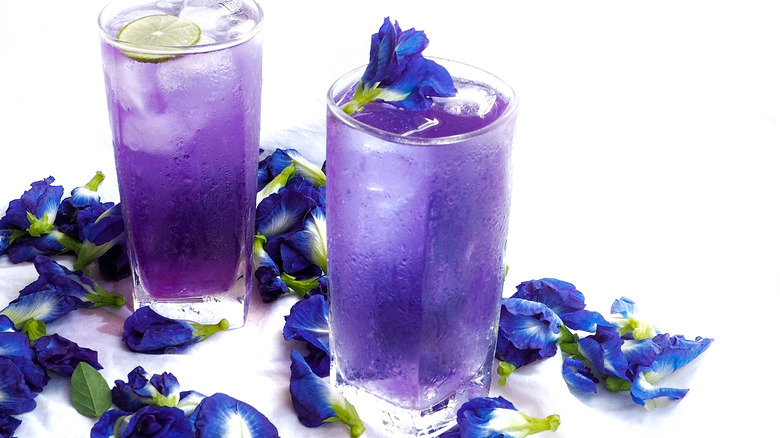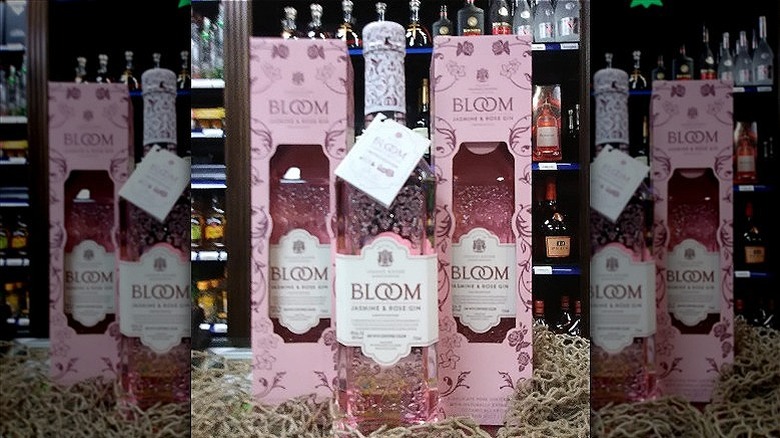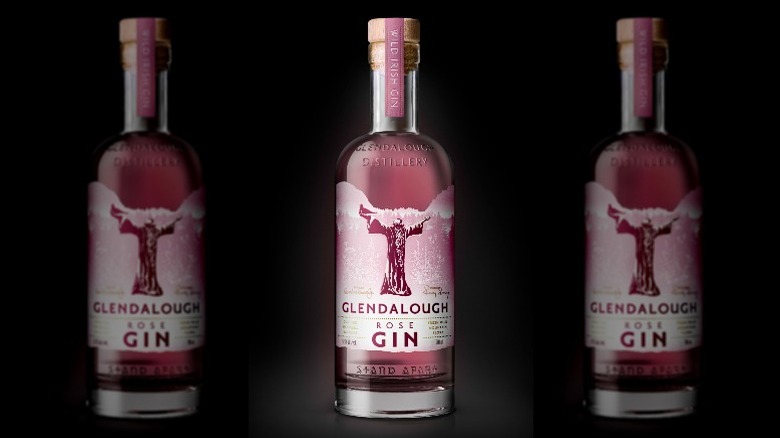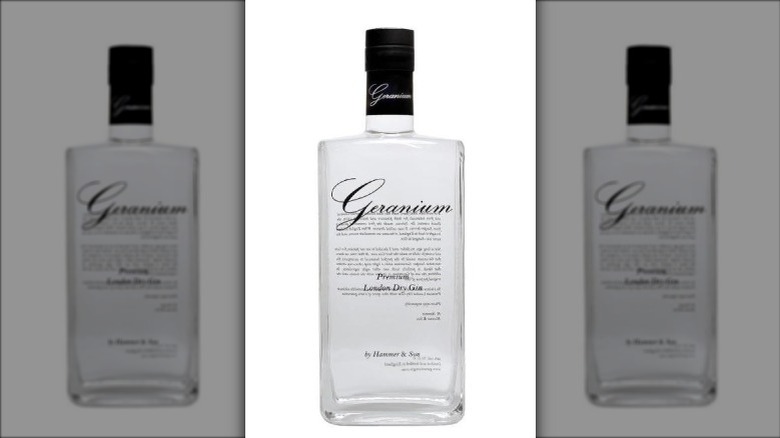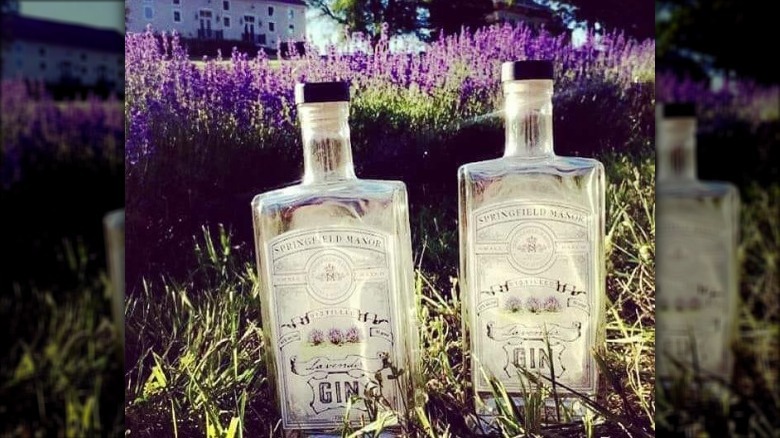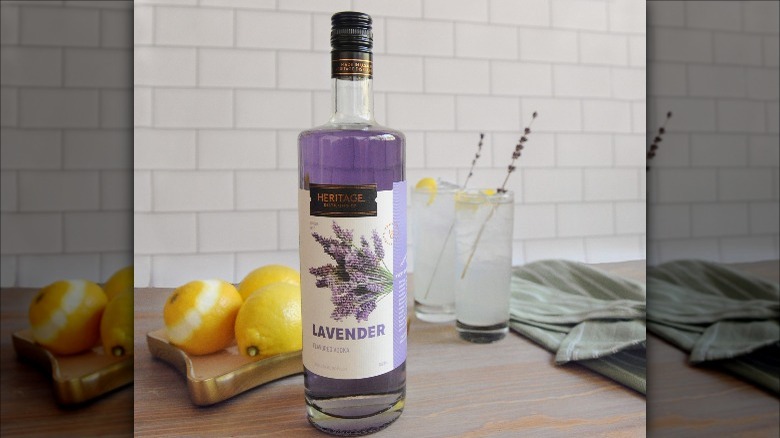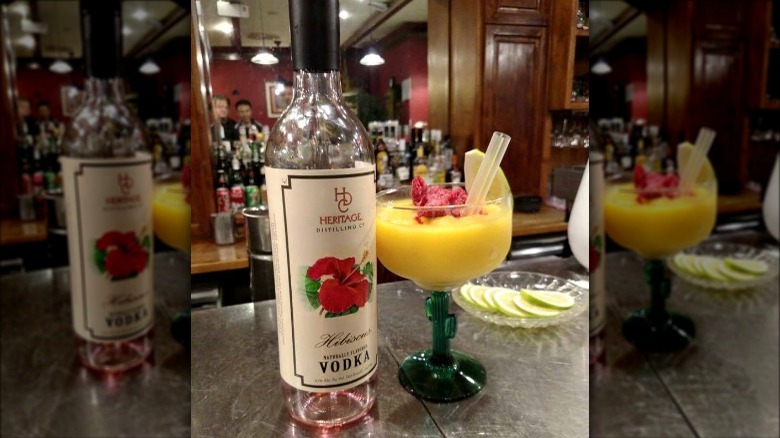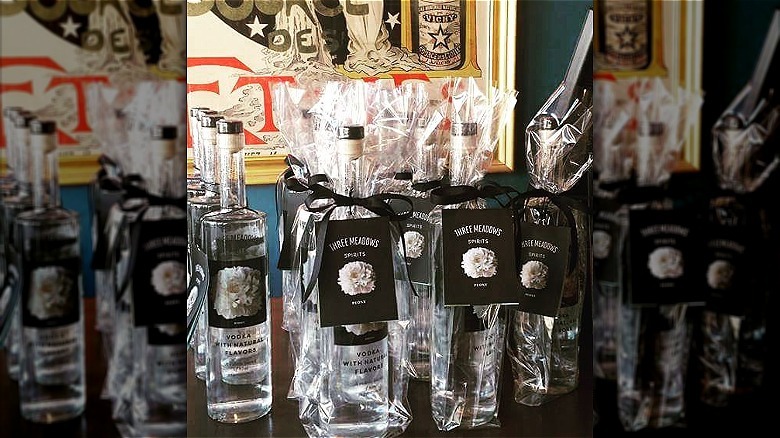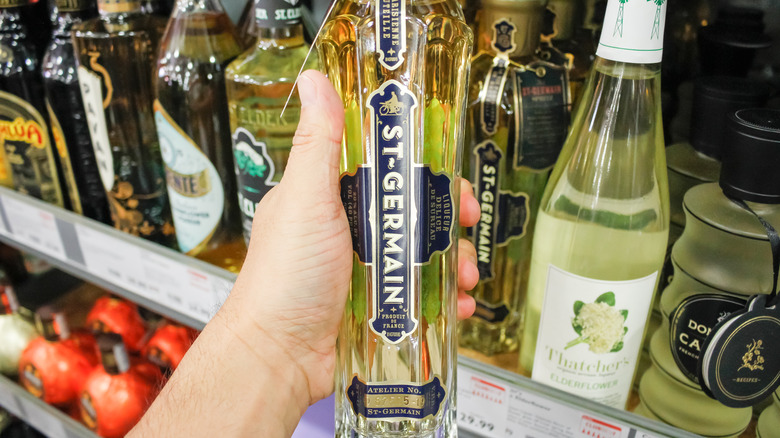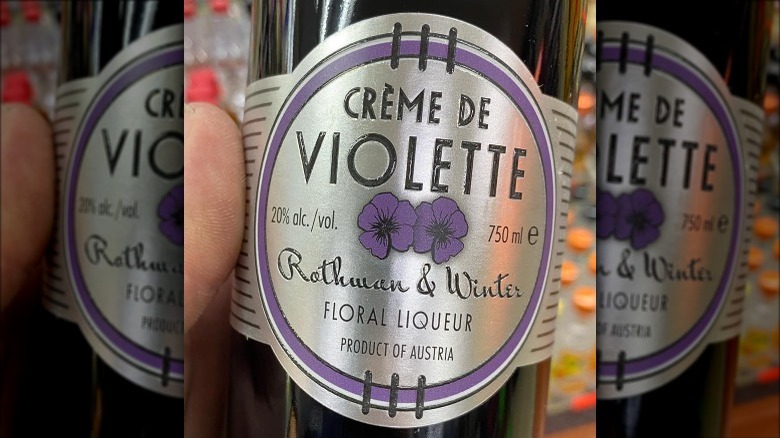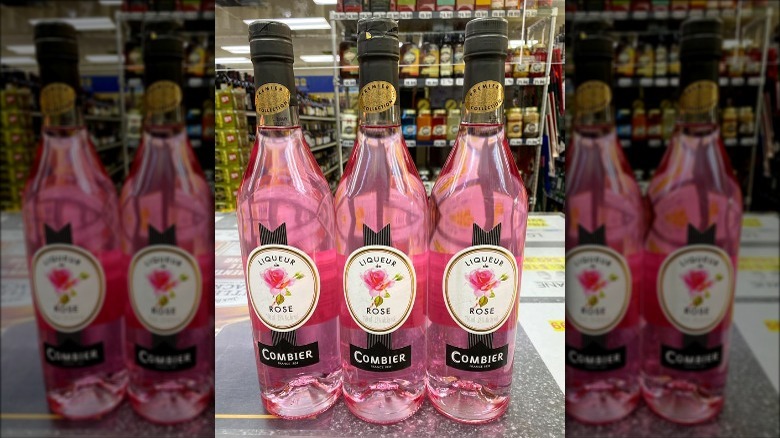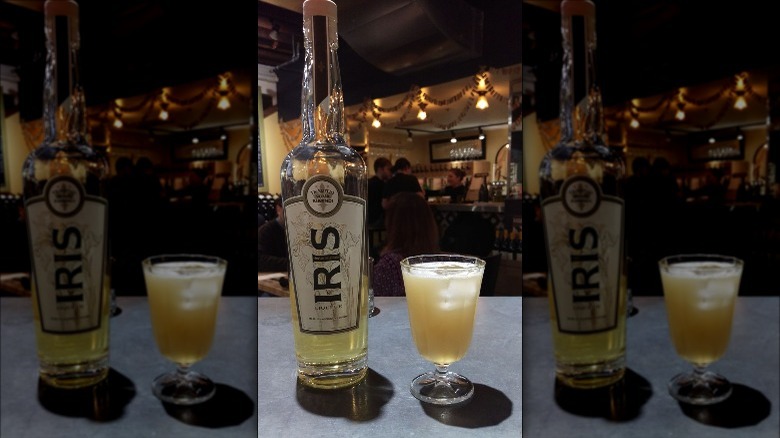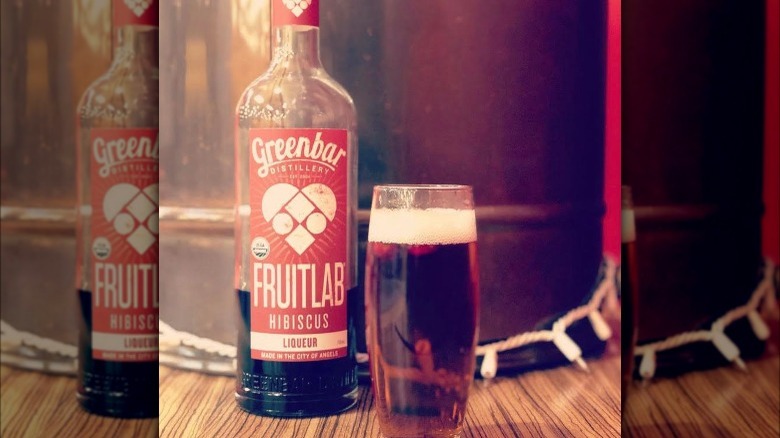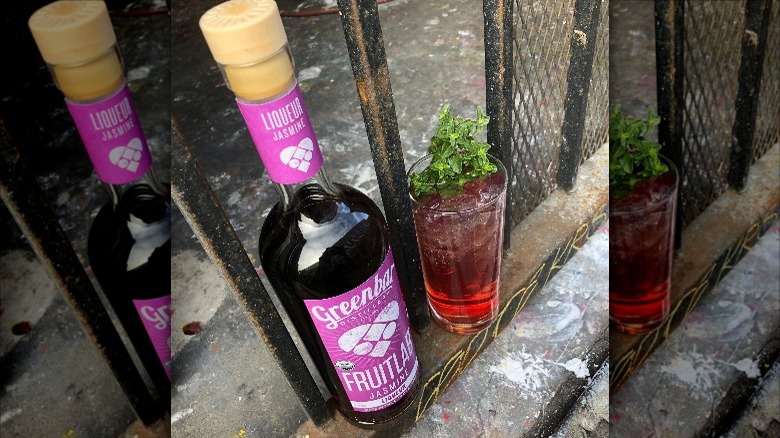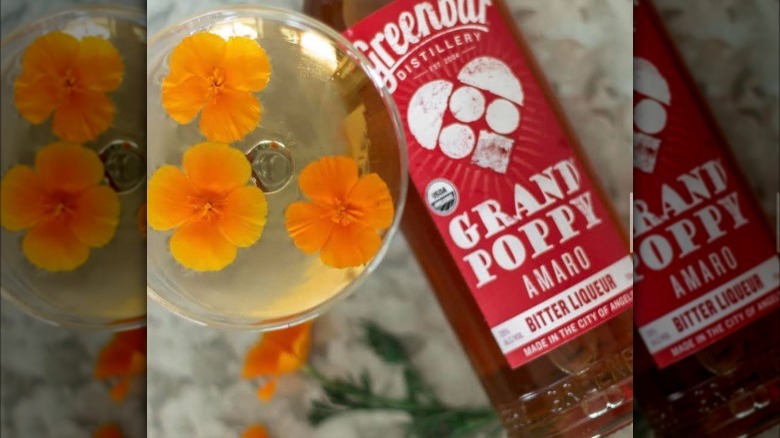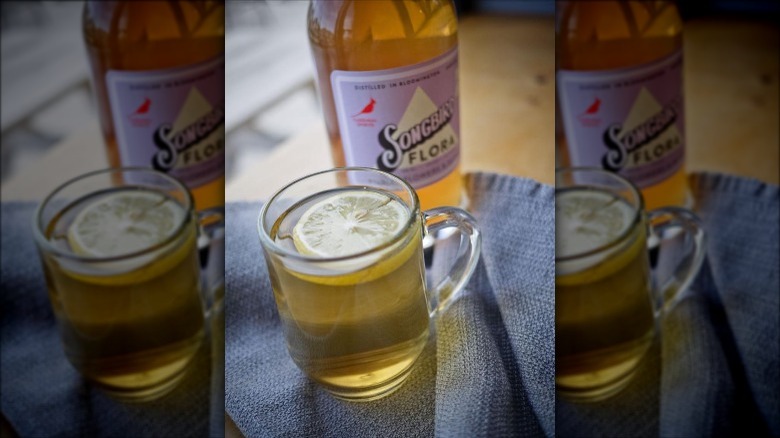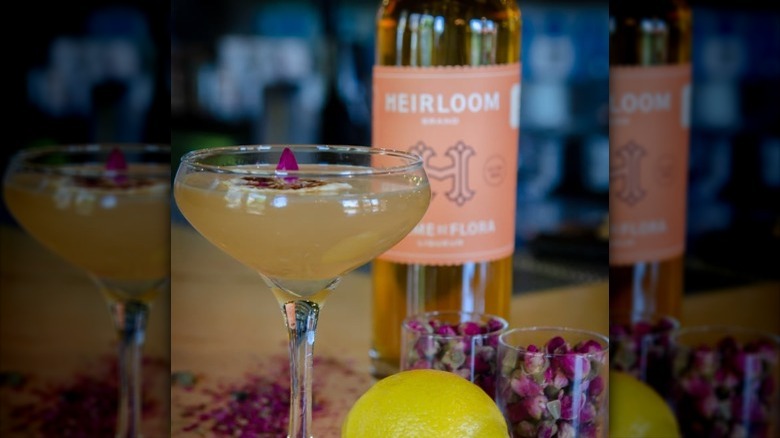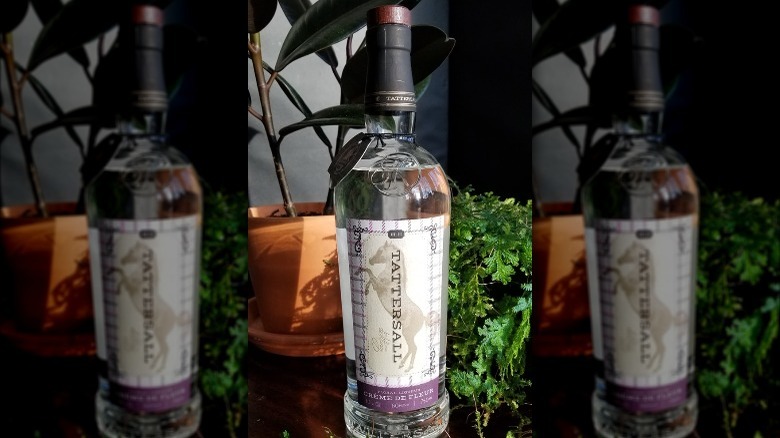Floral Spirits You Should Try At Least Once
Say it with flowers... kind of a cliché, but for birthdays, Valentine's Day, Mother's Day, date nights, apologies, and myriad other occasions, flowers make for an almost-perfect gift. Why almost? Sure, they're lovely to look at, and in many cases heavenly to smell, but they're all too ephemeral. The one thing all cut flowers are guaranteed to do is wilt and die, and even potted plants will succumb if you don't pay them more attention than is required by the average Tamagotchi.
You know what never goes bad, though? Things preserved in alcohol. Such as alcohol itself. And yes, there's quite a variety of floral-flavored spirits. Next time you want to express such flowery sentiments as "I love you," "I'm thinking of you," or "Please don't make me sleep on the couch," skip the orchids and carnations and pick a lovely geranium gin, hibiscus vodka, jasmine liqueur, or any of these other delightful blossoms in our boozy bouquet.
Bloom Jasmine & Rose Gin
Gin is a rather astringent spirit on its own, thanks to the juniper berries that flavor it –- even though "berries" is part of their name, these aren't the kind of fruit you'd want to eat on their own. Many gins, however, are made with additional flavoring ingredients collectively known as botanicals. Floral notes are a popular pairing with juniper due to the fact that their sweetness helps to temper some of the berries' bitterness. BLOOM Jasmine & Rose Gin is a pink gin that is naturally flavored (and colored) with East Asian jasmine and Moroccan rose petals, giving it a subtle sweetness that never ventures into perfumy territory.
BLOOM suggests this gin be mixed with lemonade or combined with vermouth and strawberry liqueur to make a pink martini. They've also created a cocktail called the Eastern Rose that includes lemon juice, ginger beer, and green tea. Jasmine & Rose Gin could also be used in a classic gin and tonic, but you might want to swap out the lime garnish for a sweet/tart fruit like raspberries or blackberries.
Glendalough Rose Gin
Glendalough Rose Gin is a spirit with a sad, yet sweet backstory: it was created by the head distiller for his brother's wedding and named in honor of their recently deceased mom whose name was Rose. Rose isn't just the gin's name but its flavor, though, and the roses used to make it are said to come from the garden planted by the original Rose as well as the wild roses that grow in the mountains surrounding the distillery. (Glendalough, which was one of Ireland's first craft distilleries, is located in County Wicklow.) The gin gets a double dose of roses as it's not only distilled with their petals but is then infused with additional rose essence before bottling. This also helps to deepen the pretty pink coloring.
DrinkHacker finds Glendalough Rose Gin to be very floral, indeed, but says that there's still some pepperiness and pine from the juniper. They recommend it in a G&T as they find that the tonic helps to balance the flowery sweetness, although the dry vermouth in a martini could do the same thing. A rosy-pink gin fizz would also make for a delightful summertime drink, particularly when garnished with fresh strawberries.
Hammer & Son Geranium Gin
Geraniums are a less-familiar flavoring flower, whether for gins or anything else. The distillers at Hammer & Son, however, felt that this not-too-perfumey, peppery-scented flower would make for the perfect semi-floral gin, making for a beverage that would retain the dryness characteristic of a London Dry style gin and yet have a certain aromatic quality. While it took some doing to figure out the best way to extract the geranium oil during the gin-making process, the father and son distilling duo benefited from the former's experience as a chemist. The resulting gin they created combines juniper's astringency with what they describe as the "citrus-rosy" flavor from the flowers.
Hammer & Son Geranium Gin is that rare gin that blends well across the board, as was the distillers' intent. It works well in G&Ts and martinis, but it can also be used in a fruitier gin drink like the blackberry-flavored bramble or sweet cocktails like the Pink Lady and Bee's Knees.
Springfield Manor Lavender Gin
Lavender is another floral that, on its own, isn't really all that sweet, nor is it any sweeter when paired with juniper. For that reason, lavender gin is a floral spirit that's not super-flowery. It's a fairly popular gin flavoring, one that may be used on its own (in addition to the juniper, of course) or in combination with other botanicals. Of all the lavender gins out there, though, Springfield Manor is the only one made with lavender grown on an 18thcentury Maryland farm and distilled with the natural limestone-filtered springs from which the farm (and the gin) takes its name.
The Gin is In absolutely raved about Springfield Manor Lavender Gin — the exact words they used were "blown away." Their review sang the praises of the gin's subtle cinnamon, lemon, rose, tonka bean, and vanilla notes that only serve to enhance the lovely lavender scent and flavor. While this gin works well in simple cocktails, particularly ones with a hint of bitterness such as the pink gin (literally just gin with a few dashes of bitters), it's absolutely delightful on its own, as well.
Heritage Distilling Co Lavender Flavored Vodka
Vodka these days seems to be all about the flavors, from Ciroc's fruity fantasies to Smirnoff's sours and candy flavors. There are even a few oddball offerings out there such as Ivanabitch's tobacco vodka that are aimed (we hope) at the novelty market. Vodka does seem to have lagged behind gin when it comes to recognizing the true potential of floral flavors. At last, however, they seem to be catching up, and we're pleased to note that there is now such a thing as lavender vodka.
Heritage Distilling Co describes their vodka as "lavender flavored," something that may indicate that the lavender essence was added after the distilling process. No matter what point in the process the lavender comes into play, it gives the vodka a gorgeous purple color as well as a light floral flavor. Also on the light side is the alcohol content, as this vodka weighs in at just 30% ABV so the flavor can shine through without being overwhelmed by excess booziness. In addition to its lavender notes, Heritage Distilling Co Lavender Flavored Vodka also has hints of mint and vanilla. Such a flavor profile makes this vodka well suited to light, fresh, slightly sweet drinks, so you could try it mixed with lemonade or splash a bit into a glass of sparkling wine.
Heritage Distilling Co Hibiscus Flavored Vodka
Heritage Distilling Co is really doubling down on the floral vodkas -– quite literally, as they have exactly two of them in their current lineup which also includes such interesting options as bacon, ghost pepper, and huckleberry flavors. Blooming right alongside the lavender vodka is a hibiscus one, a not-so-surprising choice as this trendy tropical bloom has been popping up all over the foodie world for the last few years.
Heritage Distilling Co Hibiscus Flavored Vodka has a blush pink color, but the flavor profile is definitely on the sweet side. It may work as a solo sipper, at least if you're a fan of dessert-like vodkas such as Pinnacle's cake and whipped cream options. Travel Distilled, however, suggests that this fruity, sugary vodka may be at its best when combined with sour flavors like cranberry juice and lime. They also feel that, as it is a lower-alcohol vodka (30% ABV, as is Heritage's lavender version), it might be a good choice for cocktail combos including fruit-flavored brandies or triple sec. Heritage themselves like to lean into their hibiscus vodka's sweetness by recommending mixers such as limeade and fruit punch.
Three Meadows Spirits Peony Vodka
Peonies, now, aren't a flower you see on your plate every day -– nor in your glass, for that matter. That didn't stop Three Meadows Spirits from seeing how they would taste if used to infuse vodka. Pretty darn good, as it turns out. Who knows, peonies could prove to be the new hibiscus. Even if they don't take over the menu at hipster bars and bistros, they won over the floral-averse reviewers at Intoxicologist. While they found Three Meadows Spirits Peony Vodka to have some sweetness and floral notes, these are balanced out by a little bitterness and a surprising amount of pepper flavor. This peony vodka may be at its best when used in drinks typically made with gin as these are often meant to showcase the spirit's flavor rather than disguise it as may be the case with vodka drinks.
While Three Meadows Spirits Peony Vodka is still available to purchase, sadly, the distillery itself is no more. They seem to have changed their name to Three Meadows and a Pony at some point, and the peony vodka (their only product) is available under that label as well. The supply is limited, however, as the distillery's Instagram says Three Meadows (with or without pony) is "permanently closed."
St. Germain Elderflower Liqueur
Perhaps the best-known floral-flavored booze may be St. Germain, a French liqueur made from elderflowers. Elderflower-flavored everything is familiar to fans of the "Great British Baking Show," and the flavor may well have received a popularity boost from being used in the royal wedding cake when Prince Harry and Meghan Markle tied the Windsor knot. Even though a bottle of St. Germain seems to feature prominently on every bar specializing in craft cocktails these days, the liqueur itself isn't yet old enough to drink: it was born in 2007, making it just 15 years old.
In order to make St. Germain, it may take 1,000 elderflower blossoms. As the distillers say, this makes for "a bouquet in every bottle." If you're not familiar with elderflower, it has a flavor that's almost more fruity than floral, and is in fact strongly reminiscent of pears. St. Germain itself also has notes of citrus, grapefruit, honeysuckle, lychees, peaches, and passion fruit and, is typical for a liqueur, is sweet and not terribly strong (just 20% ABV). Many St. Germain cocktails are spins on old classics, i.e. the St. Germain G&T or elderflower Old Fashioned, but mixologists love to splash this versatile liqueur around to the extent that, as Difford's notes, it's earned the nickname of "bartender's ketchup."
Rothman & Winter Crème de Violette
Most of us, if we're even aware of crème de violette, know it as an essential ingredient of the trendy Aviation cocktail. In fact, this pre-Prohibition drink re-emerged into prominence again at the beginning of the 21stcentury after decades of obscurity thanks to the fact that crème de violette was once more available in the U.S. Not everyone's a fan of the Aviation -– per The New York Times, famed mixologist Dale DeGroff once described the flavor as "hand soap" -– but Ryan Reynolds is doing his darndest to keep the drink that shares his gin brand's name relevant. Free booze fans take note: he's picking up the tab for Aviations imbibed by bar patrons celebrating National Aviation Day 2022.
At present, there are several crèmes de violette available on the American market. One of the best is Rothman & Winter, an Austrian brand that dates back to the 1930s and flavors their brandy-based liqueur with violets from the Austrian Alps. Rothman & Winter Crème de Violette has a perfumey scent and a super-sweet, candy-like taste (with, yes, a slight hint of soap), but it's such a pretty purple color and the flavor works well in combination with other ingredients. Besides being used in the Aviation, crème de violette also features prominently in the Blue Moon, which is basically the same drink minus the maraschino, and can also be mixed with sparkling wine.
Combier Rose Liqueur
While St. Germain and crème de violette may be the best-known floral liqueurs, they're not the only ones out there. French distiller Combier, known for their fruit liqueurs and absinthe, also offers both a violet and elderflower liqueur. Where they break out from the pack, though, is by featuring a rose liqueur in their lineup. This drink is made by steeping rose petals (hand-picked French ones, no less) in sugar beet alcohol.
Customers of online liquor store Bitters and Bottles rate Combier Rose Liqueur a full five stars. One person likes to sip theirs straight up, noting, "The gentle rose flavor is soothing instead of strong — it's hinted of rose instead of tasting like your grandma's old perfume." (Something that isn't always the case when craft cocktail makers go too heavy-handed with bottled rosewater). Another reviewer suggests mixing this rose liqueur with vodka, fresh lemon juice, and raspberry puree to make a refreshing raspberry rose cocktail. Yet another way to enjoy Combier Rose Liqueur is to mix it with champagne — mais oui!
Elixir Craft Spirits Iris Liqueur
Elixir Craft Spirits is an Oregon craft distiller founded by two Italian brothers who describe their mission as "revivifying traditional spirits in the Italian tradition." While some of their spirits do seem to be traditional ones, such as the amaro Calisaya and the Tuscan herbal liqueur Ver, other offerings like the gold leaf-flecked Fête vodka seem to be branching out a bit. Most intriguing to us is the Iris liqueur, the first one on the market to be distilled from the root of this particular botanical.
The flavor of Iris is difficult to describe, but seems to somehow combine the flowery sweetness of a crème de violette with a more bitter herbal note somewhat reminiscent of grapefruit. There's even a certain citrusy tartness to it, as well. Summit Sips was wowed by the unusual Iris liqueur, going so far as to create a new cocktail by combining it with equal parts of gin, luxardo, and lime juice. In addition to this drink, which they've dubbed "Delayed Echo," this liqueur can also be sipped straight or used in place of Benedictine.
Greenbar Distillery Fruitlab Hibiscus Liqueur
Greenbar, a distillery that claims to be the first one established in Los Angeles since Prohibition, is not one to specialize in any particular spirit. They not only cover the bases with gin, vodka, whiskey, tequila, and rum, but they also make amaro, bitters, canned cocktails/mocktails, and liqueurs. Among their liqueurs is a highly rated hibiscus one. Wine Enthusiast lives up to its name by enthusing over Greenbar's Fruitlab Hibiscus Liqueur and awarding it a 96 point rating. They praise its bright red color as well as a flavor that combines sweet-tart raspberry jam-like fruitiness with just a hint of florality.
As with the hibiscus vodka covered in a previous slide, Fruitlab Hibiscus works well in any drinks where you want a touch of fruit. You might like to try it in a margarita or a strawberry daiquiri, as Greenbar suggests that it complements both tequila and rum. You could also do a tropical spin on a Kir Royale by splashing this hibiscus liqueur into a glass of sparkling wine.
Greenbar Distillery Fruitlab Jasmine Liqueur
While the hibiscus liqueur is part of Greenbriar Distillery's standard lineup, they also have a jasmine variety that seems to be more of a seasonal or occasional offering. Fruitlab Jasmine Liqueur is something that was first created a dozen years ago in response to demand from bartenders, and Greenbriar's distillers said it took some doing to retain that sweet, delicate jasmine flavor while making the liqueur robust enough to hold its own in cocktails. In addition to jasmine blossoms, this liqueur also incorporates green and black teas as well as a little citrus flavoring, but the overall taste sensation is floral through and through.
As to how to use the Fruitlab Jasmine Liqueur, it mixes well with gin, adding a sweet and flowery note that softens some of that spirit's harsher qualities. The jasmine flavor also works well in rum drinks and can be a delightful addition to a wine spritzer or glass of sparkling wine.
Greenbar Distillery Grand Poppy Amaro
In addition to its liqueurs, Greenbar Distillery also offers an amaro that includes a unique ingredient: California poppies. Poppy Amaro combines these flowers with cane sugar, molasses, grapefruit, orange, lemon, and a wide range of botanicals including pink peppercorns, blessed thistle, dandelion, rue, gentian, geraniums, cherry bark, burdock, California bay leaf, and something called bearberries. (Eat the Planet says this last-named ingredient is flavorless when raw, but cranberry-like when cooked.)
So what does this interesting admixture taste like? According to Greenbar Distillery, Poppy Amaro is basically the Golden State in a bottle. It's an amaro, of course, so it's on the bitter side, but with some floral sweetness, earthy notes, and a fair amount of citrus flavor from the three different types with which it's made. It can be mixed with seltzer for a simple spritzer, but also works well in a Paper Plane, a Negroni, or anywhere else you'd typically use an amaro,
Cardinal Spirits Songbird Flora
Cardinal Spirits is a Bloomington, Indiana, craft distiller known not only for its liquors (whiskey, vodka, rum, gin, brandy, amaro, and a blackberry-flavored bramble), but for canned cocktails and even hand sanitizer. And yes, they do offer a small selection of liqueurs. Songbird Flora is perhaps the standout in this last-named category, a spirit with a flavor the distillers say is meant to evoke "what hummingbirds taste when they drink nectar from flowers." Okay, so hummingbirds aren't technically songbirds per se due to their having less-than-robust vocal cords, but it's a nice thought nonetheless. The floral blend used to flavor the liqueur includes jasmine, elderflower, and hibiscus, these being blended with raspberry and sweetened with agave..
As Songbird Flora is both fruity and floral, but not overwhelmingly so, it can be used in a variety of different ways. Cardinal Spirits suggests mixing it in an Old Fashioned (a Midwestern-style brandy one, of course), using it in a spritzer, spiking a cup of chamomile tea, or even baking it into macarons if your pâtisserie skills are sufficient to tackle this tricky treat.
Heirloom Creme de Flora
Great distillers think alike when it comes to naming their products, or perhaps it's just a Midwestern thing — Milwaukee-based Heirloom Liquors also have a liqueur they call Flora. Heirloom's Creme de Flora, to give it its proper name, resembles Cardinal Spirits' Songbird Flora in appearance, but the only floral ingredient the two liqueurs have in common is lavender as Heirloom omits the elderflower, hibiscus, and raspberry. Instead, Creme de Flora includes marigold, chamomile, jasmine, and rose.
Creme de Flora can be used in champagne cocktails, but it can also stand in for the crème de violette in an Aviation, replace the Cointreau used in a Sidecar, or substitute for St. Germain in drinks where the latter is typically used. This liqueur is tasty enough to shine on its own in simpler preparations, as well. As Heirloom founder Brandon Reyes told the Chicago Tribune, he once mixed it with passion fruit LaCroix (another Wisconsin product) and was pleasantly surprised by the results. "It had no business being that good," he said.
Tattersall Crème de Fleur
Tattersall Distilling also makes a floral blend liqueur, but theirs, at least, does not share a name with any of the fairy godmothers in Disney's Sleeping Beauty as they call it Crème de Fleur (making it a character in the Potter-verse, instead). Crème de Fleur is, however, also made in the Midwest –- Minneapolis, in this case. Okay, we are hereby crowning this region the official homeland of floral liqueurs. Of all the flower-blend liqueurs, Crème de Fleur has the most bountiful blooms as it includes seven different types of flowers plus additional botanicals. We're not sure which ones, though, as Tattersall does not mention them by name.
It may not actually matter that we don't know the flowers in this boozy bouquet. As one Distiller review noted, "It's difficult to pick out any single floral aroma or flavor, which is what sets this floral liqueur apart from its ilk." We think this is meant in a good way as they awarded it a score of 91 overall. As this drink is less sweet than many of its fellow florals, it's suitable for sipping on its own. It also works well in gin drinks like the G&T, Tom Collins, gin fizz, gimlet, and French 75 and can be added to a sangria or mixed with ginger beer to make a flowery mule.
